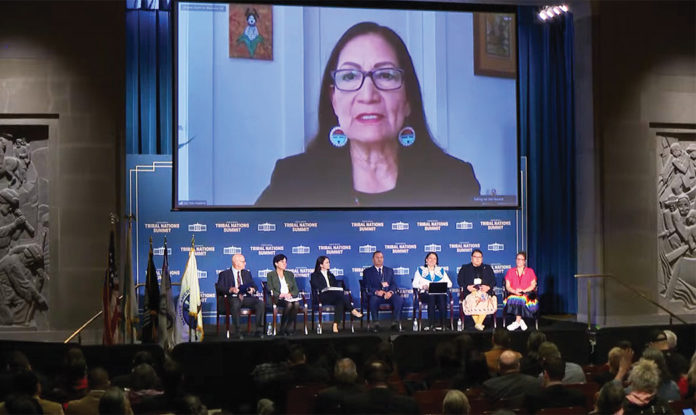WASHINGTON, D.C. – Secretary of the Interior Deb Haaland delivered virtual remarks during the Biden-Harris administration’s third White House Tribal Nations Summit at the Department of the Interior. During her remarks, Secretary Haaland highlighted the transformational investments in Indian Country made possible by President Biden’s Investing in America agenda and the administration’s historic progress to empower tribal sovereignty, self-determination and prosperity. Her remarks were as follows:
“Guw’aadzi haupa – Greetings Tribal leaders, elders, veterans, community members, and friends.
I am so honored to welcome you to the Biden-Harris administration’s third annual White House Tribal Nations Summit, and I’m so sad not to be there in person. I wish I could be with you all to gather and connect, but it turns out that not even I am immune to COVID.
In some ways, me being sick is a good way to remind all of us of where we have been in the years since the pandemic impacted the globe, and of course put a spotlight onto the inequities we have always known exist in Indigenous communities.
In three years, we’ve made big, challenging, and transformative accomplishments – all with representation from all of you. This is our third year in office and now things look very different, because we have taken your words and feedback and put them into action.
Throughout this administration, our work is guided by Indian Country, for Indian Country. Because representation matters. It matters in how we advocate for resources, guide investments, and act on policy that impacts our people, now and into the future.
As you’ll hear over the next few days, we’ve made significant progress this year through investments in infrastructure, communities, and people.
Across President Biden’s Investing in America agenda, a historic $45 billion – more than 15-years’ worth of the Bureau of Indian Affairs’ annual budget – has gone into Indian Country. You’ve heard me say it before, but that number bears repeating: a $45 billion investment in Indian Country!
With that comes transformational change.
We’re protecting cultural resources like salmon, which Pacific Northwest tribes have stewarded for thousands of years. This year, I was humbled to celebrate an agreement between the federal government and the Coeur d’Alene, Colville, and Spokane Tribes to reintroduce salmon into the Upper Columbia River and protect the health and longevity of these sacred waters.
We’re making long-overdue investments in critical water infrastructure for communities like the Hopi Tribe in Arizona. Since the 1960’s, the tribe has suffered from toxic levels of arsenic in its water supply. But, with over $15 million in Bipartisan Infrastructure Law funding, this hazard will soon be a thing of the past. I was grateful to visit Hopi to support this project.
We’re also boosting local economies. In May, I joined the Mescalero Apache Nation in New Mexico to celebrate the groundbreaking of a new project funded by the Bipartisan Infrastructure Law that will provide a safer travel route through the community and in turn boost the tribe’s local economy.
And we’re directing billions in funding to tribes to plug harmful orphaned oil and gas wells – industry relics that spew toxic gasses and threaten the health of our communities. The Department recently announced $40 million for this initiative as a piece of our broader effort to address environmental injustice across Indian Country.
We know that gaining access to federal resources is not always easy, particularly for smaller tribes. Through the White House Council on Native American Affairs, which I co-chair with Domestic Policy Advisor Neera Tanden, we will make sure that we’re not just delivering more resources for Indian Country, but that they are getting to Indian Country.
You’ll hear from the President later today about exciting new announcements, but I want to focus on one in particular: Through the Access to Capital Initiative, we are publishing a new draft Request for Information (RFI). Once finalized, this RFI will help the federal government identify – for the first time – tribal nations’ access to, and need for, federal funding. We’ll be taking this draft directly to tribes for consultation in January of next year, and we welcome your feedback. Once final, I hope that all of you consider filling this out. It will be an incredibly valuable tool in finally assessing what the total need is in your communities.
We are working to remedy decades of underfunding, and that includes harnessing the purchasing power of the federal government. The Buy Indian Act is one of our best tools for empowering Native-owned businesses as federal contractors. Interior’s bureaus awarded over $1.4 billion to Native-owned businesses in fiscal year 2023, with Indian Affairs bureaus awarding more than 70 percent of eligible contract funds to Native business owners. These achievements are significant.
This is why representation matters.
For decades the federal government worked to oppress Indian people through policies like forced removal, termination, adoptions of Indian children, land fractionation, language loss, and assimilation through federal Indian boarding schools. But this year – decades after these devastating polices were implemented – we had some big news in the effort to rebuild what was taken from us.
First, the Supreme Court stood behind the Indian Child Welfare Act. The forced removal of Indian children from their families was a targeted attack that inflicted trauma on children, families, and communities that people continue to feel today. This important decision upheld what presidents and congressional majorities on both sides of the aisle and all of us have recognized for the past four decades.
Earlier this week, we announced the conclusion of the Land Buy-Back Program for Tribal Nations. This program partnered with more than 50 tribes in 15 states to consolidate and restore tribal trust ownership on nearly three million acres. More than $1.69 billion was paid to more than 123,000 individuals, $60 million contributed to the Cobell Education Scholarship Fund, and more than 12,000 scholarships awarded to date. I’m very proud of the Department’s work to implement this program and realize Elouise Cobell’s vision to restore tribal homelands.
Today, we will publish final amendments to the Department’s fee-to-trust regulations that will make the land into trust process more efficient. This is another step to put power back in the hands of tribal communities in determining how their lands are used.
Our Federal Indian Boarding School Initiative has also taken several important steps forward. Remember that last year we published Volume 1 of an investigative report that examined the role of the federal government and this Department in perpetrating these policies. Early next year, we expect to release Volume 2, informed in part by our experiences on “The Road to Healing.” With the support of Assistant Secretary Bryan Newland and his team, we completed 12 stops across Indian Country on “The Road to Healing.” We heard directly from survivors, descendants, and their families. I am so grateful to those of you who hosted us on this journey. It was an honor to be with you and your communities to listen, share, and heal together.
Now, with new funding from the Mellon Foundation and the National Endowment for the Humanities, we’ve launched an oral history project to document the experiences of Indigenous children who attended the federal boarding school system. I’m excited to see what this work – and a collaboration with the Smithsonian Institute – will produce, because all Americans should know of this history.
It is undeniable that federal policies set out to break Indigenous peoples, to destroy our cultures, our lifeways, and our inherent connection to the land. I think it is also undeniable that those policies failed. They failed to break us, and now, we’re bringing every resource to bear to restore what they set out to destroy.
I want to talk about several ways we’re doing this. One is in addressing the centuries-long epidemics of Missing and Murdered Indigenous Peoples and Human Trafficking. As a Congresswoman, I championed the Not Invisible Act, and it gives me great pride to see it implemented as Secretary. The Not Invisible Act Commission, established by our agency and the Justice Department, recently submitted its recommendations to our Departments and to Congress on how to best address this crisis. The implementation of these recommendations is crucial. We must call out the gaps that persist among federal, state, county, and tribal law enforcement agencies. And we must implement collaborative, case-specific task forces in partnership with regional law enforcement and Tribal communities.
Another step we are taking is addressing the protection and preservation of Indigenous resources and cultures across our country through updates to the Native American Graves Protection and Repatriation Act. Today, we are publishing a final rule to use this essential tool for the safe return of sacred objects to the communities from which they were stolen and to strengthen the authority and role of Indigenous communities in the repatriation process.
Importantly, we’re also investing in the protection of Indigenous languages. Alongside the Department of Education and other partners, we are developing a 10-year National Plan – guided by tribal leaders and Native language teachers – to revitalize our languages through an all-of-government strategy.
Rebuilding our bonds means ensuring that tribes have a meaningful role in the protection of the lands and waters they have always cared for. This year, we celebrated President Biden’s designation of two new national monuments that have tribal co-management as a foundation of their establishment. From the desert valley of Avi Kwa Ame National Monument to the sprawling majesty of Baaj Nwaavjo I’tah Kukveni – Ancestral Footprints of the Grand Canyon National Monument – tribes are a vital part of how these special places will be shared with the world.
At last year’s summit, we announced that 20 co-stewardship agreements had been signed by our administration in the previous year. Well, in the year since, another 190 co-stewardship agreements have been signed by our administration. Tribes from coast to coast play a greater role in the management of the lands and waters they have cared for since time immemorial.
This year, we worked to put $2 billion from our Investing in America agenda toward the protection of at-risk ecosystems. From the Bison that roam the iconic prairie grasslands, to the salmon of Alaska’s rivers, we’re incorporating Indigenous knowledge into every facet of this work.
Today, our Department is publishing a new chapter in our Departmental Manual that formalizes Indigenous knowledge as a foundational piece of our mission. It is essential that we do everything we can to ensure that Indigenous knowledge helps guide our ongoing work. Because by acknowledging and empowering Tribes as partners in co-stewardship of our country’s lands and waters, every American will benefit from strengthened management of our federal land and resources.
These changes build on ongoing efforts like our work to strengthen Alaska Native representation on the Federal Subsistence Board and to elevate the Office of Subsistence Management within the Department, which the President proposed in his fiscal year 2024 request to Congress.
I often think of the world we are leaving to our children – the young people who are already taking action to defend our planet. That’s why I launched the Indian Youth Service Corps, and why we’re supercharging this effort with $15 million from the Inflation Reduction Act.
It’s why we’re partnering with AmeriCorps and the Aspen Institute to help post-secondary Native students excel, while building the public-private partnerships we need to create additional community-led projects across the country.
It’s why we worked to remove the sq__ word from more than 650 geographic features, and why our Advisory Committee on Reconciliation and Place Names is working with communities to identify other locations where derogatory names must be changed.
And it’s why we’re investing in the education and advancement of Native youth. I’m so grateful to the teachers, faculty and staff across Bureau of Indian Education schools, who instill in our children the knowledge and wisdom they need to excel in our ever-changing world. With tools like the Great American Outdoors Act, we are investing $285 million into BIE schools for improved infrastructure, classrooms, and so much more.
Our students deserve every resource possible to foster exceptional learning and to connect them with everything the world – and the internet – has to offer. That’s why this administration has focused on bringing reliable high-speed internet to tribal lands, which remain the most digitally disconnected areas in the United States. The important progress on the Tribal Spectrum memorandum, signed between federal agencies and our new Office of Indigenous Connectivity and Technology, will accelerate this work. In fact, we’re advertising for a new Director as we speak.
As I wrap up – I want to talk about how we tell our stories.
There are parts of our history that are painful, but they do not define us. We define ourselves by the world we collectively build for current and future generations. It is up to all of us to tell our stories. And not just the stories of the bad times – but of those that we celebrate. Those that show our resilience, our strength, and our contributions.
That’s why I’ve challenged the National Park Service to think about how, as the nation’s storyteller, they can partner with Tribes to tell a more complete story of American history, including how our national parks interpret and preserve our history, such as the boarding school and assimilation eras.
I’m also pleased to announce the launch of a new theme study – led by the Park Service – to broaden how we interpret and understand the Indian Reorganization Period – one of the most consequential periods of our history.
Stretching from the 1930’s to the 1950’s, we saw – for the first time since colonization – federal support for Indigenous cultures, economic recovery, self-determination, and governance. While injustices and the continued implementation of assimilation policies persisted in many Indigenous communities, this is a period that deserves our attention. I look forward to seeing what the Service creates with the help and input of our communities.
If there’s one thing you feel hopeful about today, let it be this: the progress we’ve made together is substantial, it is history making, and it’s thanks to the folks in this room and in our communities that we are building a future our people deserve.
You’ll see a different format for the summit this year, informed by your feedback, to create more opportunities to engage directly with agency leaders in nation-to-nation discussions.
I’m so grateful for the roles you all play in this essential and shared work. Thank you so much for being here and for your faith and commitment that together, we will continue to build progress for our future.
Dawaa’e.“















































